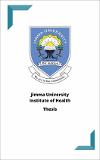IPHC-E Repository System
Occupational health and safety of health workers at public health facilities of Wolaita zone, Southern Ethiopia
- Home
- →
- Universities
- →
- Jimma University, Institute of Health
- →
- JU Theses and Dissertations
- →
- View Item
JavaScript is disabled for your browser. Some features of this site may not work without it.
| dc.contributor.advisor | ||
| dc.contributor.author | Gebremariam, Yemane | |
| dc.date.accessioned | 2021-05-12T12:57:30Z | |
| dc.date.available | 2021-05-12T12:57:30Z | |
| dc.date.issued | 2011-05-31 | |
| dc.identifier.uri | http://repository.iifphc.org/handle/123456789/1321 | |
| dc.identifier.uri | https://repository.ju.edu.et/handle/123456789/2368 | |
| dc.description.abstract | Background: Globally, poor occupational health and safety results in 271 million work related injuries, 2 million work-related deaths and 160 million work-related diseases per year. In developing countries, the risk is 10 to 20 times higher than in developed counties. In Ethiopia, the epidemiology of work related injuries were not adequately documented. Objective: To assess occupational health and safety practices at public health facilities in Wolaita Zone, Southern Nations and Nationality People Region, Ethiopia, 2011. Methods: A cross-sectional Study was conducted during March15 to April 15, 2011 among 390 health professionals. Semi-structured self administered questionnaire and in depth interview guide were used for quantitative and qualitative methods of data collection respectively. For quantitative part of the study all the health professionals from the selected Woredas were recruited. Data were entered into SPSS version 16. Binary and multiple logistic regressions were used to estimate the crude and adjusted odds ratios for the prevalence of injury respectively. Result: A total of 351 health workers were included in the study and 326(92.9%) of the health workers were knowledgeable on occupational health and safety measures and 67(19.1%) had history of injury within the past 12 months. Clinical nurse encountered physical injuries more than any of the professional categories (61%) followed by the midwives (18%). Health workers working in hospital were 2 times higher to have incidence of injury as compared with working in health centre (OR=1.90, 95% CI of (1.087, 3.475). Conclusion and recommendation: More than three fourth of the health workers were knowledgeable on occupational health and safety. Most of the health workers use personal protective equipments but shortage of materials is a common problem. Employees should get training on occupational health and safety and necessary protective materials should be provided. | |
| dc.language.iso | English | |
| dc.publisher | Jimma University | |
| dc.subject | Occupational health & safety | |
| dc.title | Occupational health and safety of health workers at public health facilities of Wolaita zone, Southern Ethiopia | |
| dc.type | Thesis |
